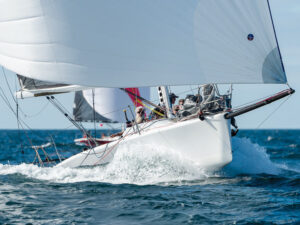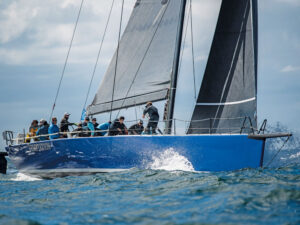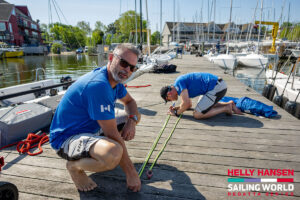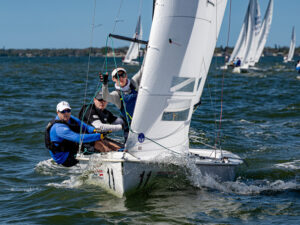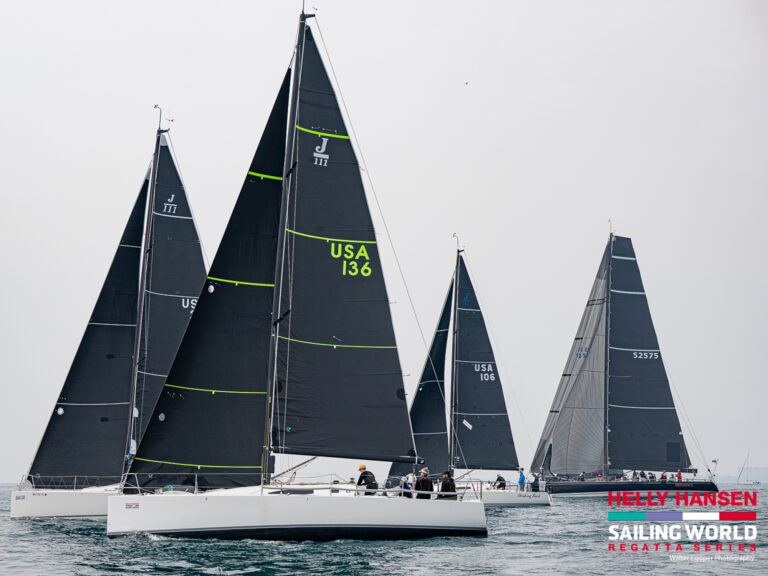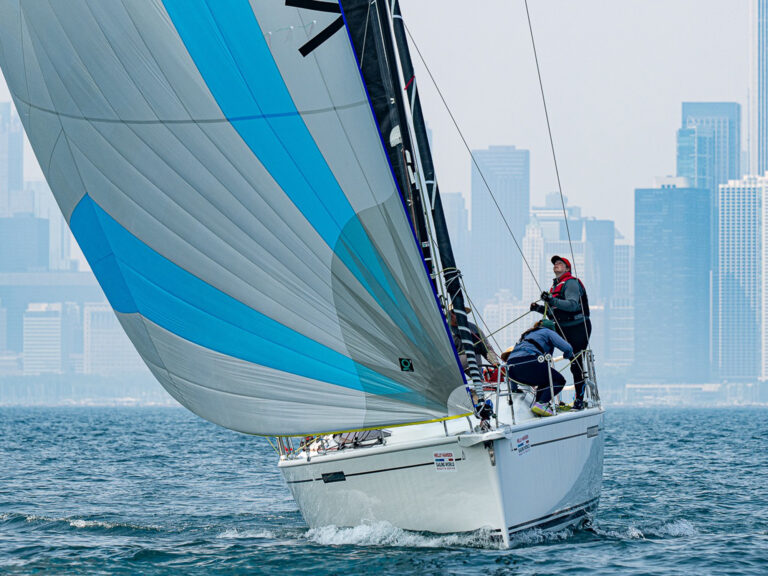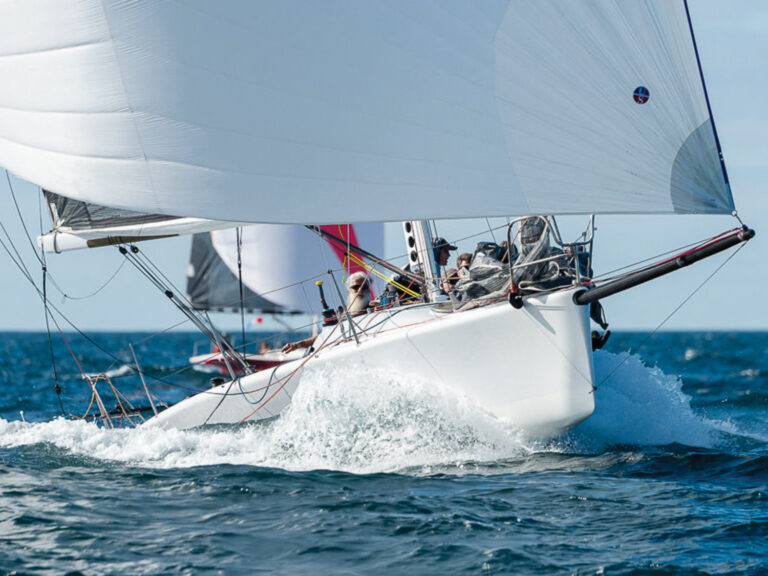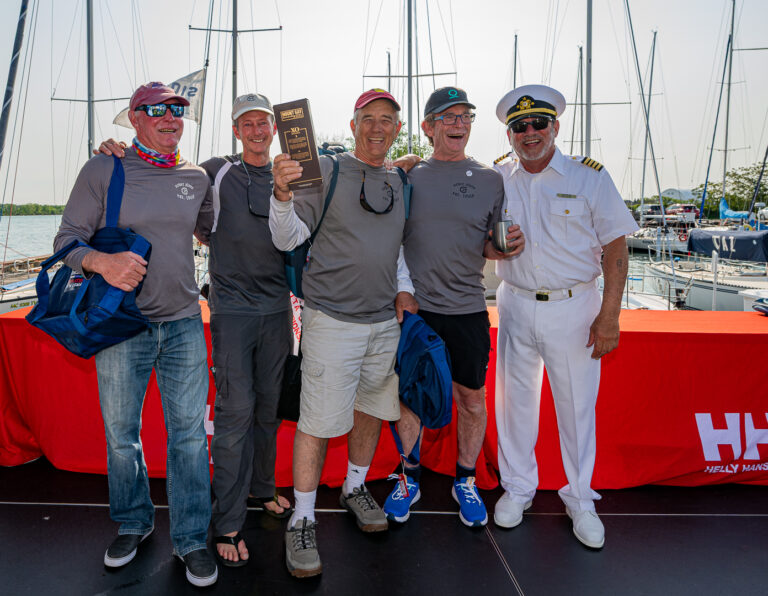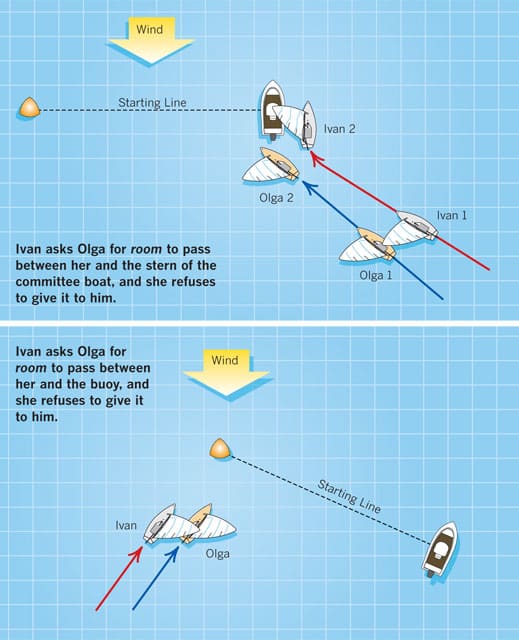
Room at a start
A reader recently wrote asking several questions, which inspired the following discussion of rules that apply at starting marks. The three diagrams show the three types of starting marks that you are likely to encounter—an anchored committee boat from which the starting line extends, a small buoy, usually serving as the port-end starting mark, and a flag staff on the end of a pier.
“When is an object at one end of the line an obstruction, and when is it a mark?” the reader asked. The definition Mark implies that the committee boat (but not its anchor line and any object accidentally or temporarily attached to it), the buoy (but not its anchor line), and the flag at the end of the pier are all marks, and, when a mark is set, it is always a mark. An object that is a mark can also be an obstruction if it satisfies the criterion in the first sentence of the definition Obstruction. In our examples, the committee boat meets the criterion for an obstruction, but the buoy does not. The buoy is so small that, if one of the dinghies shown in the diagram were sailing directly toward it and was one of her hull lengths from it, she could pass it without changing course substantially. The flag on the pier is not an obstruction, but the pier itself is. Any obstruction, other than a boat racing, is an obstruction at all times.
Now let’s consider how the Part 2 rules apply to the three situations shown in the diagrams. In each case Ivan and Olga are two overlapped boats on the same tack sailing toward a starting mark. The inside boat, Ivan, asks the outside boat, Olga, for room to pass to leeward of the mark. Olga holds her course and refuses to give Ivan room. The three situations are very simple and easy to visualize, but the rules that apply depend on which mark the boats are approaching, and when they are approaching it. I will discuss each incident in the diagrams under four different assumptions about the time when it occurs. The times are shown in bold below.
In all cases, the only Part 2 rules that apply are Rule 11, requiring the windward boat, Ivan, to keep clear of the leeward boat, Olga, and Rule 14, requiring both boats to avoid contact if reasonably possible. In addition to the Part 2 rules, Rule 16.1 does not apply because Olga holds her course. Rule 31 must be considered in addition to the Part 2 rules. A boat breaks Rule 31 if, while she is racing, she touches a starting mark after her preparatory signal and before she completes the first leg of the course.
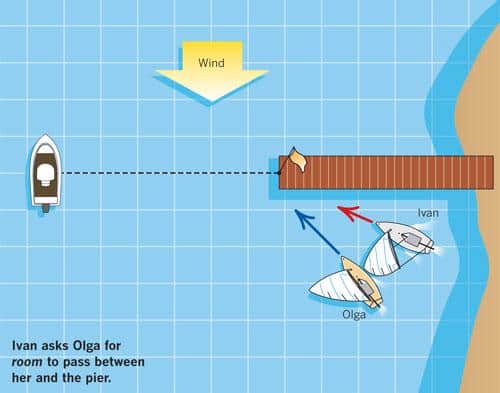
The incidents occur after the preparatory signal while both boats are on their final approach to the mark to start: At the committee boat or the small buoy, both of which are surrounded by navigable water, Rules 18 and 19 do not apply. Provided Ivan does not force Olga to change course, neither boat breaks a rule. Ivan is “barging” and, to avoid breaking a rule, he must pass the mark on the wrong side.
At the pier, the starting mark is not surrounded by navigable water, and the mark has a required side—that is, it must be left to starboard (see Rule 28.2). Rule 18 applies because the boats are required to leave the mark on the same side (see Rule 18.1) and, for the same reason, Rule 19 does not apply (see Rule 19.1). Rule 18.2 requires Olga to give Ivan mark-room, and, while taking that mark-room Ivan must, if possible, keep clear of Olga. If she doesn’t leave enough space for him to keep clear, then he is exonerated for breaking Rule 11 under Rule 18.5(a).
The incidents occur after the preparatory signal but before the boats begin their final approach to the mark to start: Let’s say there are 3 minutes to go until the starting signal, and Ivan and Olga are approaching the line to confirm which end is favored. Because they are not on their final approach, the Section C preamble does not “switch off” the Section C rules. Nevertheless, Rule 18 does not apply because the boats are not yet required to leave the mark on the same side (see Rule 28.2).
Because both the committee boat and the pier are obstructions, Rule 19 applies as the boats pass either of them (see Rule 19.1). Under Rule 19.2(b), Olga as the outside boat is required to give Ivan room to pass between her and the obstruction. As Ivan takes room given to him by Olga, he is required by Rule 11 to keep clear of her. If, as shown in the first diagram, Olga denies Ivan room, then she has broken Rule 19.2(b).
At the small buoy, Rule 19 does not apply because the mark is not an obstruction. Rule 11 applies, and, because Olga is denying him room, Ivan must leave that buoy to starboard.
Suppose that Ivan and Olga are in different classes with different starting times and that the incidents occur after Ivan’s preparatory signal but before Olga’s preparatory signal: Ivan is racing, but Olga is not (see the definition Racing). If Olga interferes with Ivan in any way, she breaks Rule 23.1. At all three marks Olga denies Ivan room that he would obviously have had if she had stayed out of the area where the boats racing were maneuvering to start. Therefore, Olga does break Rule 23.1, and, because she is not racing, she cannot take a Two-Turns Penalty (see Rule 44.1). Her penalty is to retire. My advice to Ivan is, even though he is annoyed by Olga interfering with his starting plans, he should keep clear of her as required by Rule 11 and, if possible, avoid contact as required by Rule 14. If he were to break either Rule 11 or 14, or both, he could take a Two-Turns Penalty and continue to race. If he were to touch the mark, he could take a One-Turn Penalty. However, if Olga’s interference compelled him to break Rule 11, 14, or 31, then he would be exonerated under Rule 64.1(c).
The incidents occur before the preparatory signal for either boat: Rule 23.1 does not apply between them because it only applies between two boats when one of them is racing and the other is not. Other Part 2 rules do apply between them because they are sailing in the starting area and intend to race (see the Part 2 preamble). Rule 31 does not apply to either of them because they are not yet racing.
At the committee boat and at the pier, Rule 18 does not apply because the mark does not yet have a required side for either boat. But Rule 19.2(b) does apply, and it requires Olga to give Ivan room to pass between her and the obstruction. Ivan is required by Rule 11 to keep clear of Olga. If one of the boats breaks a Part 2 rule, she cannot be penalized and is therefore under no obligation to take a Two-Turns Penalty. However, if there is damage or injury, she may be liable for the costs incurred (see the US Sailing prescription to Rule 68).

